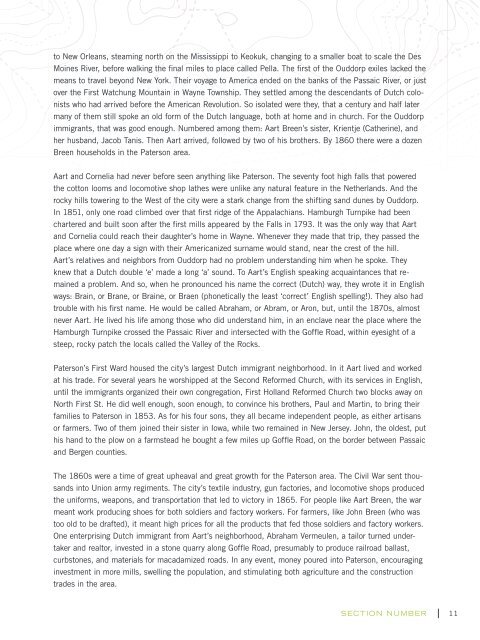BraenBook-TemplatePages
You also want an ePaper? Increase the reach of your titles
YUMPU automatically turns print PDFs into web optimized ePapers that Google loves.
to New Orleans, steaming north on the Mississippi to Keokuk, changing to a smaller boat to scale the Des<br />
Moines River, before walking the final miles to place called Pella. The first of the Ouddorp exiles lacked the<br />
means to travel beyond New York. Their voyage to America ended on the banks of the Passaic River, or just<br />
over the First Watchung Mountain in Wayne Township. They settled among the descendants of Dutch colonists<br />
who had arrived before the American Revolution. So isolated were they, that a century and half later<br />
many of them still spoke an old form of the Dutch language, both at home and in church. For the Ouddorp<br />
immigrants, that was good enough. Numbered among them: Aart Breen’s sister, Krientje (Catherine), and<br />
her husband, Jacob Tanis. Then Aart arrived, followed by two of his brothers. By 1860 there were a dozen<br />
Breen households in the Paterson area.<br />
Aart and Cornelia had never before seen anything like Paterson. The seventy foot high falls that powered<br />
the cotton looms and locomotive shop lathes were unlike any natural feature in the Netherlands. And the<br />
rocky hills towering to the West of the city were a stark change from the shifting sand dunes by Ouddorp.<br />
In 1851, only one road climbed over that first ridge of the Appalachians. Hamburgh Turnpike had been<br />
chartered and built soon after the first mills appeared by the Falls in 1793. It was the only way that Aart<br />
and Cornelia could reach their daughter’s home in Wayne. Whenever they made that trip, they passed the<br />
place where one day a sign with their Americanized surname would stand, near the crest of the hill.<br />
Aart’s relatives and neighbors from Ouddorp had no problem understanding him when he spoke. They<br />
knew that a Dutch double ‘e’ made a long ‘a’ sound. To Aart’s English speaking acquaintances that remained<br />
a problem. And so, when he pronounced his name the correct (Dutch) way, they wrote it in English<br />
ways: Brain, or Brane, or Braine, or Braen (phonetically the least ‘correct’ English spelling!). They also had<br />
trouble with his first name. He would be called Abraham, or Abram, or Aron, but, until the 1870s, almost<br />
never Aart. He lived his life among those who did understand him, in an enclave near the place where the<br />
Hamburgh Turnpike crossed the Passaic River and intersected with the Goffle Road, within eyesight of a<br />
steep, rocky patch the locals called the Valley of the Rocks.<br />
Paterson’s First Ward housed the city’s largest Dutch immigrant neighborhood. In it Aart lived and worked<br />
at his trade. For several years he worshipped at the Second Reformed Church, with its services in English,<br />
until the immigrants organized their own congregation, First Holland Reformed Church two blocks away on<br />
North First St. He did well enough, soon enough, to convince his brothers, Paul and Martin, to bring their<br />
families to Paterson in 1853. As for his four sons, they all became independent people, as either artisans<br />
or farmers. Two of them joined their sister in Iowa, while two remained in New Jersey. John, the oldest, put<br />
his hand to the plow on a farmstead he bought a few miles up Goffle Road, on the border between Passaic<br />
and Bergen counties.<br />
The 1860s were a time of great upheaval and great growth for the Paterson area. The Civil War sent thousands<br />
into Union army regiments. The city’s textile industry, gun factories, and locomotive shops produced<br />
the uniforms, weapons, and transportation that led to victory in 1865. For people like Aart Breen, the war<br />
meant work producing shoes for both soldiers and factory workers. For farmers, like John Breen (who was<br />
too old to be drafted), it meant high prices for all the products that fed those soldiers and factory workers.<br />
One enterprising Dutch immigrant from Aart’s neighborhood, Abraham Vermeulen, a tailor turned undertaker<br />
and realtor, invested in a stone quarry along Goffle Road, presumably to produce railroad ballast,<br />
curbstones, and materials for macadamized roads. In any event, money poured into Paterson, encouraging<br />
investment in more mills, swelling the population, and stimulating both agriculture and the construction<br />
trades in the area.<br />
SECTION NUMBER 11


